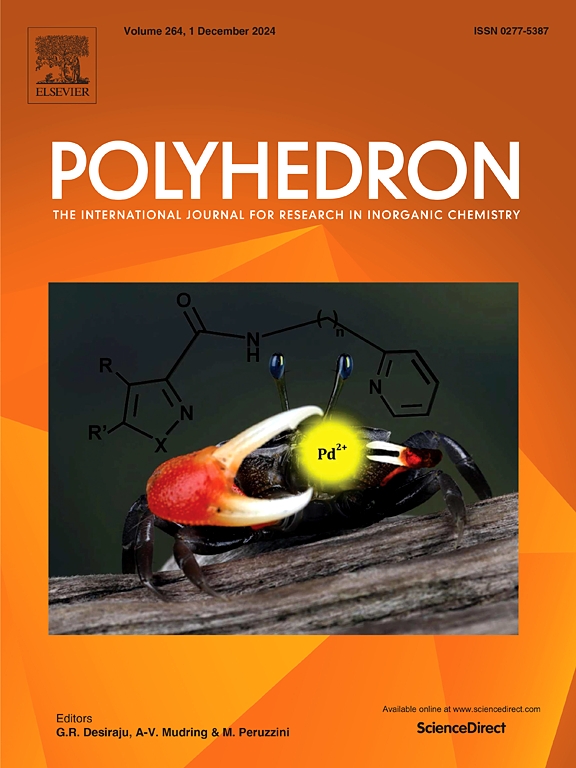Unveiling the efficacy of bimetallic nanoparticles in carboxymethyl cellulose based nanocomposite for imidacloprid remediation
IF 2.4
3区 化学
Q2 CHEMISTRY, INORGANIC & NUCLEAR
引用次数: 0
Abstract
In recent work, a novel nanocomposite CuO/SnO2@CMC was synthesized from bimetallic nanoparticles of copper and tin combined with carboxymethyl cellulose (CMC). This nanocomposite was applied to remove the imidacloprid pesticide from water-based solutions. The synthesized nanomaterial was analyzed via UV–Visible spectroscopy, XRD, TGA, FTIR, EDX and SEM to evaluate its chemical composition, thermal stability, optical properties, morphology, and size. Many factors such as concentration of the pesticide, contact time, solution pH, and catalyst dosage were investigated and optimized for the removal of imidacloprid from aqueous media. The maximum removal efficiency of imidacloprid was achieved using CuO/SnO2@CMC nanocomposite at pH 9, with a 4 mg adsorbent dosage, 5 mg/L pesticide concentration, at 45 °C, in 120 min. The experimental data best fit the pseudo-second-order kinetic model. Freundlich and Langmuir models explained the nature of adsorption and among them the Langmuir model was found to follow more closely. Thermodynamic parameters explained the spontaneous and endothermic nature of the adsorption process. The recovery and reusability of CuO/SnO2@CMC nanocomposite were studied, and it was concluded that the nanocomposite can be used 4 times for the imidacloprid adsorption process.

揭示羧甲基纤维素基纳米复合材料中双金属纳米颗粒对吡虫啉的修复效果
本文将铜锡双金属纳米颗粒与羧甲基纤维素(CMC)结合,合成了一种新型纳米复合材料CuO/SnO2@CMC。该纳米复合材料用于去除水基溶液中的吡虫啉农药。通过紫外可见光谱、XRD、TGA、FTIR、EDX和SEM对合成的纳米材料进行分析,评价其化学成分、热稳定性、光学性能、形貌和尺寸。考察了农药浓度、接触时间、溶液pH、催化剂用量等因素对吡虫啉的去除效果。在pH为9、吸附剂用量为4 mg、农药浓度为5 mg/L、温度为45℃、时间为120 min的条件下,CuO/SnO2@CMC纳米复合材料对吡虫啉的去除效果最佳。Freundlich模型和Langmuir模型解释了吸附的性质,其中Langmuir模型被发现更接近。热力学参数解释了吸附过程的自发和吸热性质。研究了CuO/SnO2@CMC纳米复合材料的回收率和可重复使用性,得出该纳米复合材料可用于吡虫啉吸附4次的结论。
本文章由计算机程序翻译,如有差异,请以英文原文为准。
求助全文
约1分钟内获得全文
求助全文
来源期刊

Polyhedron
化学-晶体学
CiteScore
4.90
自引率
7.70%
发文量
515
审稿时长
2 months
期刊介绍:
Polyhedron publishes original, fundamental, experimental and theoretical work of the highest quality in all the major areas of inorganic chemistry. This includes synthetic chemistry, coordination chemistry, organometallic chemistry, bioinorganic chemistry, and solid-state and materials chemistry.
Papers should be significant pieces of work, and all new compounds must be appropriately characterized. The inclusion of single-crystal X-ray structural data is strongly encouraged, but papers reporting only the X-ray structure determination of a single compound will usually not be considered. Papers on solid-state or materials chemistry will be expected to have a significant molecular chemistry component (such as the synthesis and characterization of the molecular precursors and/or a systematic study of the use of different precursors or reaction conditions) or demonstrate a cutting-edge application (for example inorganic materials for energy applications). Papers dealing only with stability constants are not considered.
 求助内容:
求助内容: 应助结果提醒方式:
应助结果提醒方式:


